Dan Pontefract's Blog, page 38
October 20, 2014
How TELUS Engages Employees Through Pervasive Learning
SAP was kind enough to interview me and produce a case study related to the Pervasive Learning model at TELUS, and its alignment to culture and employee engagement.
As I state in the report,
“Engagement is a multifaceted strategy. It shouldn’t be treated as a silo, as a separate line item. You can’t engage your people if you’re just yelling at them in a classroom to do better on a test. If you include learning as part of your holistic approach to your organizational culture, I think you will be in a much better spot.”
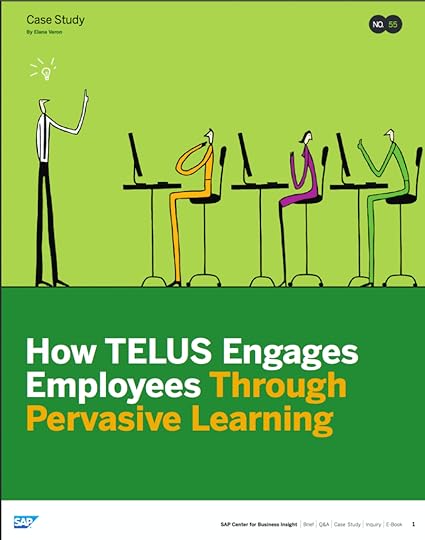 Christopher Koch, Editorial Director of the SAP Center for Business Insight, also wrote a post on LinkedIn touching on parts of the case study.
Christopher Koch, Editorial Director of the SAP Center for Business Insight, also wrote a post on LinkedIn touching on parts of the case study.
You can download a copy of the case study by clicking here or on the graphic to the right.
Dan's Related Posts:Pervasive Learning Graphic from Flat ArmyRethinking Approaches to Corporate LearningAfter Five Years In My Role We’re Hiring My Replacement. Are You Interested?Try Implementing Flexible Work Options to Increase Employee EngagementLinkedIn Skills – Useful or Useless?
October 14, 2014
In Honour of Ada Lovelace
 Today, October 14, 2014, is Ada Lovelace Day – an international celebration of the achievements of women in science, technology, engineering and maths (STEM). Ada was the world’s first female computer programmer – a true icon and pioneer.
Today, October 14, 2014, is Ada Lovelace Day – an international celebration of the achievements of women in science, technology, engineering and maths (STEM). Ada was the world’s first female computer programmer – a true icon and pioneer.
Denise and I are bringing up our two girls with a focus on STEM with equal footing to writing, art, physical exercise, reading and social skills. Ours is a house where STEM is encouraged not frowned upon.
When Claire – our eldest of three children – asked me one day if she could have her own blog, given she saw ‘Daddio’ doing it on a ‘more-than-regular-basis’, the answer was rather obvious. “Yes of course dear,” I replied with pride oozing out of every orifice. “Let’s pick that apple up off the ground beside the tree and see how we make it happen.”
Sadly, the metaphor was lost on her, but we got to work anyway.
Without hesitation, and within a matter of minutes, we had secured www.clairepontefract.com and opened up a WordPress site attaching it to the new domain name. (Thank the Lord there are no other Claire Pontefract’s on the planet.)
Of course, that got me thinking I should reserve www.colepontefract.com for the middle child boy and www.catepontefract.com for the third-born child, so it was a rather expensive day.
Back to Claire. She was eight years old in September of 2011 and part of the reason for wanting a blog was due to starting a new school, in a new city. She wanted a means to communicate her feelings, thoughts and ideas about such a transition. Her first post is more of an introduction, “new school. new community.” but you get the picture. I’ve always said, “behaviour before tool, and form before function” … and in this case, Claire was eager to share and communicate, not to use it as a basis for fame and/or fortune.
I was rather proud of her request. After all, she was only eight years old. I might have been in awe as well. Some have scoffed, and suggested we shouldn’t allow a young child to write in the open, divulging her real name, photos, etc. on the internet. That’s not the way we’re raising the children. The digital train left the station long ago, and our approach as parents and educators is to raise them with sufficient knowledge, STEM skills, experience and understanding about what is right and wrong in the digital hemispheres that Al Gore created for us. (bless him) If that means instructing the girls about digital predators, “bad men” and so on, how is it different from teaching them what to do in face-to-face interactions? Is learning HTML a sin?
For the record, I’ve never received an apple on Halloween with a razor blade embedded in the core, but we still check any apples that pop out of the Halloween goodie sack … out of habit from when we were children. That’s akin to letting the wee ones publicly blog, while teaching them about the good and the not-so-good of the interwebs. It should become a habit. It should become a STEM skill.
Our youngest, Cate, started kindergarten as a five-year old in 2012. Drenched in tears and a quivering lip, Cate approached Denise and I one day in early November and asked if she could start her own blog, like her big sister Claire, and of course, big brother Cole. (He had started his own blog six months earlier.) The tears stemmed from the death of our cat, Polly. Like Claire, she wanted to use the blog as a vehicle to communicate, and with her first post entitled, “How Polly Died,” Cate launched herself into the blogosphere rivaling only Robert Scoble. (Well, when he was actually blogging and not centralizing his blogging world to Facebook.)
And no, it wasn’t a typo.
She was five.
There are other reasons for allowing such public prose.
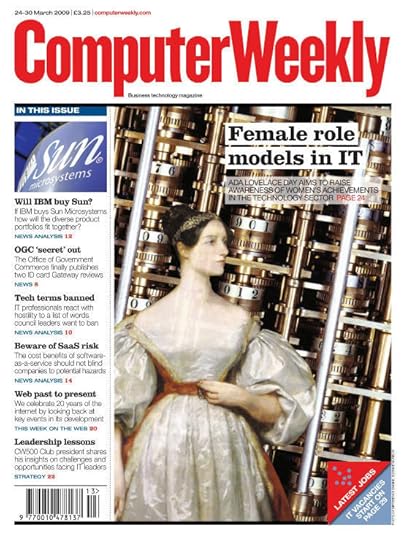 First of all, it’s a means to learning better grammar and spelling. Every story or blog post is vetted by one of the (still) happily married parents (thank you scrumptious red wine), and we use it as a teaching moment. Sometimes we sit around discussing topics or ideas, which is (I suppose) a form of family brain-storming. (hashtag #nerdfamily) What we’re trying to do somewhat surreptitiously is to improve the creativity processes and imagination habits of a wee mind.
First of all, it’s a means to learning better grammar and spelling. Every story or blog post is vetted by one of the (still) happily married parents (thank you scrumptious red wine), and we use it as a teaching moment. Sometimes we sit around discussing topics or ideas, which is (I suppose) a form of family brain-storming. (hashtag #nerdfamily) What we’re trying to do somewhat surreptitiously is to improve the creativity processes and imagination habits of a wee mind.
Secondly, no post can be published unless pre-approved by a parent. (see above) That’s where the Mommio-Daddio hierarchy kicks in.
Thirdly, being in the open is where the world is heading and we’d rather the girls be leaders in “open communication” than followers. We’d rather they be STEM leaders than not. A couple of examples come to mind. Claire loves to write about what influences her, so stories about leadership and people like Simon Ibell, Terry Fox or Rosa Parks can be found on the site. She not only learns from the writing process, she may get a comment or question or two that helps to reinforce the learning.
In the case of Cate, while younger than her older sister by four years, it’s still an opportunity to express feelings and opinions. Aside from the death of Polly, Cate will reflect (publicly) on issues like the environment or fallen soldiers.
So, Claire – now 11 – has been writing away for over three years where there have been nearly 10,000 views and 750 non-spam comments on her 75 posts. (you know, real ones from real people) She’s chuffed at the interaction she gets, that is for certain.
The younger prodigy, Cate – now 7 – has been writing for two years and has 3,200 views and 220 comments. She musters up the energy to normally write twice a month. (that’s after she is forced to cook all the meals, clean the dishes, and put out the trash … obviously)
If you’re unaware of my humour, I’m kidding.
I suppose you might say that by allowing (and thus teaching) the habits of blogging with the girls, we’re also instilling a sense of community, connection and of course pride when people view or comment on their writing.
I wouldn’t want it any other way, and I reckon the girls are in the same boat.
It’s a bit of a social science experiment – after all, anything related to parenting is a real-time experiment as there is no agreed upon blueprint – but I truly believe in the long run, this will be a good thing for them and not the opposite. Blogging — and writing in the open — is a compliment to STEM, and ultimately to Ada Lovelace.
And then one day, a different Claire Pontefract reached out to me on Twitter — based in Northern England — and I breathed a large sigh of relief knowing there will only ever be one www.clairepontefract.com out there. True story.
Pass the wine.
Dan's Related Posts:Our Three Young Children Blog … Here’s WhyAn 8 Year-Old Does Social LearningInterlocutors of 2012 (the goats are better for it)Favourite Posts of 2013 That I Wrote & PublishedThe Recalibration of Play
October 8, 2014
Perhaps the Purpose of an Organization?
The yin-yang relationship between an engaged organization and an impeccable level of customer service just might be the new purpose of an organization.
Agree?
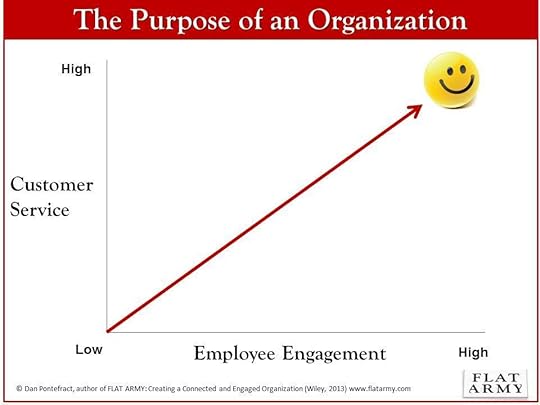
Dan's Related Posts:My PurposeKudos Jacques Godin, an Engaged Air Canada EmployeeThree Types of Workplace MindsetsMy Definition of Work and an Update on Book TwoWhy Don’t We Tip Flight Attendants?
October 5, 2014
Three Types of Workplace Mindsets
I’d be delighted to hear your opinion on the following definitions of “Workplace Mindsets” I’m toying with in relation to my next book.
Job Mindset: Employed to perform transactional duties in return for being monetarily compensated.
Career Mindset: Working in an occupation to increase the personal girth of salary, title and/or span of control.
Purpose Mindset: Passionate and committed to a meaningful & engaging workplace among all stakeholders.
I’ve already written the sections that pertain to job, career and purpose mindsets … but the definitions themselves can change.
If you have any feedback or suggestions, I’d love to read them below. Many thanks in advance. (and as is customary, I’ll be sure to attribute in the acknowledgements section of the book – after all, what good is a book if you’re not asking for opinion from time to time – even via a personal website)
Also, for the five best suggestions, I’ll happily mail a signed copy of FLAT ARMY: Creating a Connected and Engaged Organization.
Update: Oct 6 – some edits made based on feedback thus far.
Dan's Related Posts:My Definition of Work and an Update on Book TwoMy Next Role Is …Learning by OsmosisFavourite Books of 2013 That I ReadDownload Chapter 1 for Free – Flat Army: Creating a Connected and Engaged…
September 29, 2014
The Tree Hugger
 Life can be like an oak tree, with its bountiful or at times sparse acorn crops.
Life can be like an oak tree, with its bountiful or at times sparse acorn crops.
Some animals will survive on an oak’s annual output … or, due to a dearth of acorns, they may not survive at all. But each year, the oak tree is there, full of memories from previous harvests, standing tall, trying its best to produce.
Some years I feel as though I’ve received an overabundance of acorns from my oak tree, and other years I’m left wondering why I’ve been short-changed.
It’s love juxtaposed with pain.
It’s warmth surrounded by storm.
It’s a rainbow of irony set behind the oak itself.
In the end, however, that solid, unwavering, stoic oak tree is my beacon of memories. It’s my tree-ring of the past. I look to it for inspiration and for reflection.
Call me the ‘tree hugger’.
For Tim McDonald
Dan's Related Posts:We Are All BostonFor every fall there is a spring in our stepConnected Leader Attributes Graphic from Flat ArmyThe Fifteen Habits of a Connected LeaderInterlocutors of 2012 (the goats are better for it)
Try Implementing Flexible Work Options to Increase Employee Engagement
We are in the midst of one of the greatest eras of technological, social and cultural change. Today, mobile and other technologies keep us constantly connected, and this shift has affected how we interact with our families, how we spend our leisure time, and naturally, how we work.
This change is creating an opportunity for companies to shift how they think about and conduct the daily practice of work. And businesses are starting to make the shift. According to IDC, the mobile worker population is set to increase to 73% of the workforce by 2016. Interestingly, there is a correlation to workers who are offered a flexible work arrangement and both loyalty and productivity. For example, a Harris/Decima study found that 67% of workers were more loyal to companies that offer a flexible work environment, and 73% stated that that it positively affected their productivity.

I work at TELUS, and have done so since late 2008. It has been a remarkable journey, one that I’m proud to be associated with. One particular component to our relative success is we’ve developed something called Work Styles™. It’s a program more than a technology. At its root, Work Styles is a cultural shift towards empowering team members with the tools, resources and support they need to work when and where they’re most effective and productive. To put things into perspective, we’re an $11.7 billion global company with over 45,000 employees.
We’ve realized some fantastic and positive outcomes of the Work Styles program, including how it:
Increases employee engagement and promotes healthy work-life balance;
Differentiates employers in attracting and retaining top talent;
Reduces real estate footprint and environmental impact;
Produces significant cost savings for the company.
How we know it works
To confirm the success of our Work Styles program, we commissioned Western University’s Richard Ivey School of Business to conduct a study between February 2013 and February 2014.
The study included focus groups and quantitative research to compare office resident, home, and mobile knowledge workers. More than 2,000 knowledge workers and managers at TELUS participated in the research.
The study found that Work Styles is associated with many positive outcomes and confirmed TELUS’ belief that the most engaged and productive team members are empowered to work when and where they are most productive. The study also revealed areas where team members faced challenges in a Work Styles environment, uncovering invaluable insight for leaders.
Empowering employees to work when and where they are most productive offers four big business benefits:
Increased employee engagement: Mobile and at-home employees reported that their work interfered less with their home lives than their in-office counterparts. We credit improved work-life balance as playing a key role in the company’s world-leading employee engagement score which has risen from 53% to 83% over the same time period. Engagement scores for mobile and at-home team members are even higher at 84% and 85% respectively.
Attracting and retaining top talent: As an increasing number of millennials enter the workplace, flexible working programs can be a huge differentiator for employers trying to recruit and retain a new generation of workers. We’ve witnessed the number of resumes received into TELUS double since 2010. The study also found that mobile and at-home workers were less likely to leave their jobs.
Reduced operating costs: With employees working from home, organizations can reduce their real-estate footprint, leading to significant savings in lease and energy costs. Large companies with offices across the country can also save millions in travel costs each year by investing in tools and technology to collaborate remotely. In 2013 we realized $14 million in travel savings alone, and reduced our overall real estate leasing costs by $40 million with a 40% reduction in real estate our overall footprint.
Lower carbon footprint: When companies downsize their office spaces and cut down on business trips, not only are they saving money, they’re reducing carbon emissions by several thousand tonnes. By eliminating commutes, companies can also help take cars off the road. At TELUS, Work Styles helped eliminate more than 19 million kilometers and 1.1 million hours of commuting in 2013.
“With Work Styles, TELUS team members maintained their performance, exhibited increased loyalty, and experienced lower stress and less family/job conflict.” Alison Konrad, Professor of Organizational Behaviour, The Richard Ivey School of Business (co-author of the study)
Other interesting tidbits from the study included:
Mobile and at-home workers reported better work-life balance.
98% of mobile workers and 99% of at-home workers reported low to moderate impact of work duties on their home and family life, compared to 71% of resident workers.
Mobile and at-home workers demonstrated increased loyalty.
100% of mobile and at-home workers were considered low-risk of leaving TELUS.
Mobile and at-home workers were considered equally productive as their resident colleagues.
Leaders showed no differences in their ratings of productivity or performance of mobile, at-home and resident workers.
We aren’t the only ones to realize significant correlation between a flexible work program and bottom line benefits. In a study where call center agents were given the opportunity to work from home for nine months, Stanford University Professor of Economics, Nicholas Bloom, found that those working from home were more than 13% productive, quit 50% less and indicated they were much happier on the job.
Because of the success of the program, we’ve set a goal to have 70% of the TELUS workforce “Work Styled” by 2015. We currently sit at just over 60%. We’ve also set a goal to achieve 90% employee engagement by 2018.
Do you think the two are related?
I’m confident we’ll achieve both of those goals. If you’re interested in such change at your organization, we can help out too. Or, watch this short Work Styles video to view it in action.
Dan's Related Posts:Five Essential Tips to Effectively Work from HomeFlexible Working WorksGoing Forward to the Past: Management Yahooliganism & No Longer Working From HomeDocking Employee Pay to Improve Their Skills is Dubious if not DumbEmployee Access to Social Media in the Workplace Decreases
September 25, 2014
Docking Employee Pay to Improve Their Skills is Dubious if not Dumb
I read with disdain about IBM’s dubious plan to reduce the pay of some of its workers by 10 percent in order for them to improve their skills.
Patrick Thibodeau of Computerworld reported the finding on September 15, 2014. He asked IBM spokeswoman Trink Guarino about the initiative:
“IBM is implementing a skills development program for a small number of U.S. employees. Under this program, these employees will spend one day a week developing skills in key growth areas such as cloud, analytics, mobile and social.”
That’s just about the point at which I went into a silent fit of apoplectic rage.
Here’s my view on the matter.
 An employer has the fiduciary responsibility to employees to provide the learning, development and training required for them to successfully perform in their current role.
An employer has the fiduciary responsibility to employees to provide the learning, development and training required for them to successfully perform in their current role.
Put another way, an employee has the contractual right to the necessary learning, development and training for them to perform per the responsibilities and actions as outlined in their contract of employment or role description. (whichever makes the most sense)
For an employee seeking new responsibilities — and thus a new role or promotion — in the organization, the fiduciary responsibility between the organization and the employee no longer exists. In fact, an employee must earn the right to receive such investment.
Simply put: current role requirements is a company responsibility and next role possibilities is earned. (although when earned, the company is making the investment as well)
It seemed to me in this example that IBM is applying the sharpest of their nails on the chalkboard of stupidity, eliciting shrieking sounds that have sent animals of all makes into fits of confusing bewilderment.
If the company requires these 100 or so employees to ramp up their ‘current role’ skills on such aspects as “cloud, analytics, mobile and social,” perhaps they’ve forgotten it’s actually their responsibility in which to do so. If it’s a requirement for their existing role, it’s IBM’s fiduciary responsibility to the employee to provide such development.
So, it seems they are in fact doing this … however, how does the organization look itself in the mirror of employee engagement and think that docking the pay of these poor 100 employees by 10 percent is also on the menu of a fiduciary responsibility?
It’s appalling.
I’m left speechless, flabbergasted and irate.
My heart goes out to these 100 people, but so too it goes out to the entire organization.
I hope it is reversed for the sake of company-wide employee engagement, not to mention their brand and potential customer backlash.
Docking employee pay to improve their skills is dubious if not dumb.
Dan's Related Posts:My Definition of Work and an Update on Book TwoRedefining the Social Employee5 Use Cases for Badges in the EnterpriseCoaching Should Be An Expectation Of All Connected LeadersWhat is Engagement Anyway?
September 23, 2014
Reflecting on Potential Workplace Trends
I recently had the chance to reflect on the ‘future of the organization’. I suppose it’s one of my hobbies. Thanks to the kind folks at SAP, my thoughts on topics such as “What is Shared Leadership?”, “What If There Were No 9-5 Jobs?”, and “What If We Never Meet Co-Workers Face-to-Face?” have been captured and are shared below in video format.
Dan's Related Posts:5 Use Cases for a Corporate YouTube in OrganizationsLet’s Stop Penalizing the DreamersPuppetry of the MeanestFlat Army CSTD Keynote as ArtFive Uses for Virtual Worlds in the Workplace
September 22, 2014
The Write MOOC Stuff
A few years ago, I had the chance to ask Daniel Pink — author of the books Drive and To Sell is Human — if there were any secrets to his exquisite writing skill. After all, he’s sold more than five million books, so he’s obviously made some fantastic writing connections.
“Earplugs,” he said without hesitation. “When it’s crunch time, and I need to concentrate on my writing, I use earplugs.”
I’ve tried earplugs a few times — after all, it’s Dan Pink — but for some strange reason, I ended up distracted because (ironically) I couldn’t hear myself think.
 I’m in the midst of my first ever MOOC, which is the reason for this post. Offered by edX and in partnership with The University of Queensland, the course authors of Write101x English Grammar and Style asked learners to write a 300-word blog post regarding the writing-thinking-learning connection.
I’m in the midst of my first ever MOOC, which is the reason for this post. Offered by edX and in partnership with The University of Queensland, the course authors of Write101x English Grammar and Style asked learners to write a 300-word blog post regarding the writing-thinking-learning connection.
That’s when I recalled with vivid fondness my encounter with Dan Pink and his earplug writing-thinking-learning connection strategy.
I make my connection in two ways with my writing.
First, whenever I’ve met with an individual or a group of people, that conversation often triggers something in my brain. An actual connection is made, so I quickly write it down. Typically I use Evernote, the cloud-based app that encourages users to “remember everything”. The new connection is often re-purposed for other forms of writing. I suppose it’s akin to a writer’s double-entry journal where I’m thinking and learning about what I’ve unearthed.
The second connection often comes in moments of quietude. When I’m on my bike or an airplane, an idea will formulate. Wherever I might be, I will stop to write it down. It then gestates, as I think and learn how it can be used as a golden nugget for some form of prose later on.
Earplugs unnecessary. Sorry Dan.
If you’re wondering why I’ve enrolled into the Write101x English Grammar and Style course … the answer is three-fold:
MOOC
I committed to myself at the beginning of 2014 to register, participate and complete a MOOC this year. I want to learn about the MOOC culture, and particularly how edX is running their version of MOOCs. I’m honouring my commitment to learn about MOOCs by selecting a course where (I hope) thousands of users will participate so I can properly gauge for myself a) how it works and b) what pro’s and con’s there are for such a ‘massive’ course.
Grammar
I love to learn, and I love to write. The learning part is easy, the writing part is easy too … although I often make up my own language and grammar rules. (people around me call it “Danism’s” – I believe it’s a term of endearment, but I could be wrong) I thought it would be great to have a refresher on the rules I ignore. I also thought it might be good to learn a grammar lesson or two, given I have equal propensity to think I actually know what I’m doing as a writer.
Procrastination
I’m in the midst of completing Book #2 but I need a distraction. I could continue to look at real estate properties online — do we knock down a house and build from scratch, gut the interior of another, or just wait for the perfect house to show up on the market, which is likely never — or I might use my time more wisely, by knocking off bullet points number one and two from above. (besides, the book may end up being infinitely better if I up my grammar game and refrain from misuses of semi-colons and colons ad nauseam)
Dan's Related Posts:Our Three Young Children Blog … Here’s WhyLessons Learned From a First Time AuthorI Wrote a 90,000 Word Book Entirely in EvernoteInstead of Inbox Zero, How About Outbox ZeroFlat Army on the Back of a (Digital) Napkin
September 12, 2014
Apple CEO Tim Cook and his Moment of Open Culture
At Apple’s most recent product launch in Cupertino — where Apple Watch, Apple Pay and iPhone 6 (oh, and iPhone 6 Gigantic) were flaunted about like the Halloween parade I took part in at my elementary school every October as a child — a wonderful culture moment took place on stage.
No it wasn’t what the Internet is referring to as Apple Scarf Guy. (Although according to Zara, male scarves are now sold out, literally, across the planet.)
And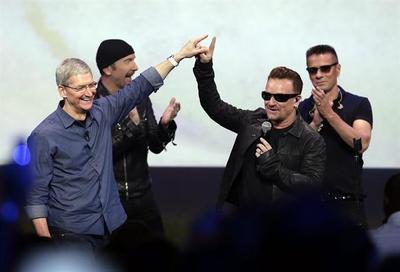 no, it wasn’t those three Irish lads from Dublin (and an Englishman) showing up on that same stage (clad in leather looking like a biker gang from Holland) singing something about Joey Ramone. They even managed to give away their new album free via iTunes to over 17 billion people. (I may have rounded up.)
no, it wasn’t those three Irish lads from Dublin (and an Englishman) showing up on that same stage (clad in leather looking like a biker gang from Holland) singing something about Joey Ramone. They even managed to give away their new album free via iTunes to over 17 billion people. (I may have rounded up.)
That did give me an idea to give away my next book — for free — via Amazon. After checking in with Amazon though, they informed me I’d have to wear leather pants and a scarf for a year, so that’s out, for now.
The culture moment I’m referring to involves Tim Cook, Apple CEO.
For fashionistas out there, I’m sorry to disappoint, but it has nothing to do with Tim’s decision to un-tuck his shirt either. I must admit, I wondered to myself if ex- Burberry CEO Angel Ahrendts — now Apple’s lead on all things retail and online stores — might have whispered into his ear just before show time,
“Tim, un-tuck that shirt or I’m jumping ship to
JC Penney or Target or Sears or any other retailer that is imploding.”
No, Tim’s culture moment was simple yet profound.
He recognized his team in a public forum.
You probably will stop reading now. After all, what does employee recognition have to do with culture let alone knowing when the next full moonrise is about to occur? (Oh the pending charm of Apple Watch)
Once 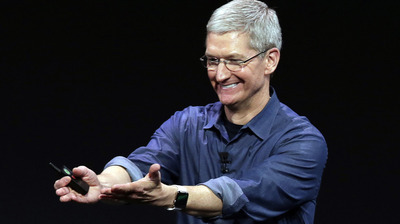 the three product launches concluded on stage, Tim paused ever so slightly, and what seemed unscripted (at least I hope it was unscripted) he asked all Apple employees present in the auditorium to rise up from their seats.
the three product launches concluded on stage, Tim paused ever so slightly, and what seemed unscripted (at least I hope it was unscripted) he asked all Apple employees present in the auditorium to rise up from their seats.
With a round of applause initiated by Tim, he thanked everyone for their hard work, their creativity and their commitment to the launch and everything leading up to the day.
This is one of the most important traits a leader — let alone the CEO of the world’s most famous fruit company — can demonstrate and act upon. Failing to recognize your employees is akin to eating sushi without soy sauce and chopsticks. When Tim took a brief moment to say thanks in front of that auditorium — and in front of the 23.4 billion people tuned into the live stream — he said to me, “My leadership style is inclusive, timely and one that supports recognition of the employee. The culture at Apple is becoming one that is open.”
After a dizzying display of jumps and high kicks by U2 front-man Bono concluded (wait, wrong decade – it’s not 1985) and the somewhat awkward announcement of a free U2 album, Tim stood alone in my mind. I’ve been publicly critical of Steve Jobs in the past, regarding his alleged and documented bouts of bullying and various “leader of people” malpractices at Apple.
When Mr. Cook decided to publicly recognize the Apple team and their performance — when he demonstrated his moment of open culture — he became more than a CEO.
He became a Chief Engagement Officer too.
(And for what it’s worth, I really like the song ‘Every Breaking Heart’ from the free U2 album. Don’t judge.)
Note: originally aired at Huffington Post
Dan's Related Posts:My Thoughts: iBooks 2, iTunes U App & iBooks AuthorHere’s to the Crazy OnesLessons in Leadership From Jim Balsillie and Mike LazaridisSteve Jobs – My Favourite BeatleAir Canada Isn’t Collaborating With Its Employees




